The vascular parkinsonism market is forecasted to grow from USD 319.5 million in 2025 to USD 538.1 million by 2035, at a CAGR of 6.20% during the forecast period. The growth is being driven by the increasing incidence of vascular parkinson's disease and the rising demand for advanced therapeutic options.
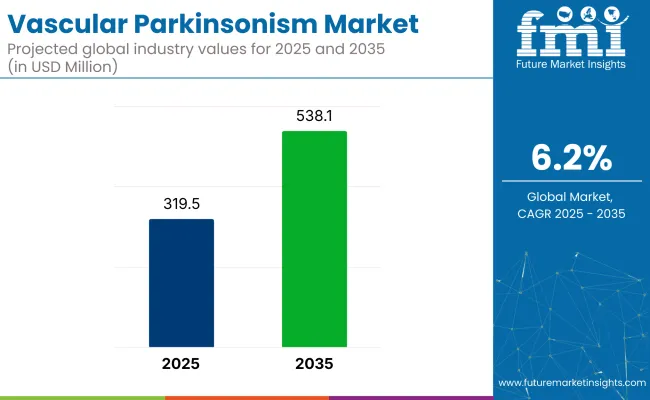
Vascular parkinsonism, caused by damage to blood vessels in the brain, is characterized by motor and non-motor symptoms. The industry is being influenced by growing awareness of vascular parkinson's disease and advancements in drug development for neurodegenerative diseases.
Vascular parkinsonism has been regarded as a niche indication within the broader neurology industry. In 2025, nearly 1.2% of the Parkinson’s therapeutics industry is expected to be captured by its treatment segment. The share within the larger movement disorders treatment industry is projected to decline to 0.6%. In the neurodegenerative disease therapeutics segment, its share is estimated at 0.35%, and in the central nervous system industry, it drops further to 0.05%.
Around 0.4% of the cerebrovascular therapies industry is anticipated to be attributed to vascular parkinsonism. This limited share is influenced by diagnostic limitations, a scarcity of approved drugs, and ongoing reliance on levodopa. Expansion is expected as screening improves and neuroprotective therapies advance.
ValtteriKaasinen, Professor of Neurology at the University of Turku and principal investigator of the study, stated on April 7, 2025, “Notably, a majority of these diagnostic changes occur within the first two years of diagnosis, which emphasises the challenges and uncertainty clinicians face in diagnosing Parkinson's disease accurately.”
A Phase 1 clinical trial at Mass General Brigham is being conducted to examine a novel treatment approach for Parkinson’s disease. In this trial, patients’ stem cells are being reprogrammed to replace dopamine-producing cells lost due to the disease. Three patients have been enrolled and treated in this first-of-its-kind autologous stem cell transplant trial. A total of six participants will be followed for 12 months to monitor the safety and effectiveness of the procedure
Strong growth is expected in the vascular parkinsonism market, driven by dopaminergic agents, oral administration routes, and retail pharmacy chains. These factors are ensuring wider accessibility and effective treatment options.
Dopaminergic agents are expected to dominate the market, holding a 42.5% share in 2025.
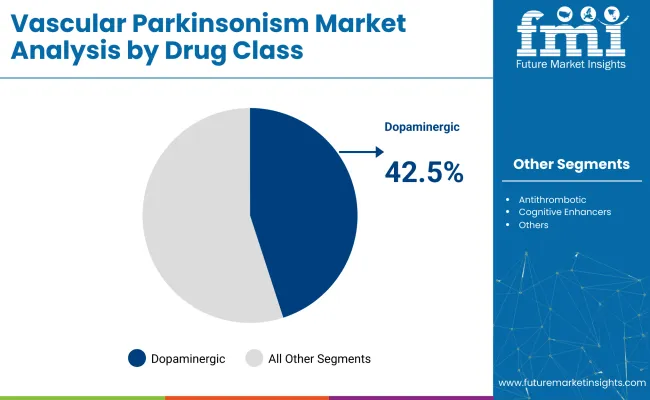
Oral medication is expected to dominate the route of administration segment, with an 81.4% share in 2025.
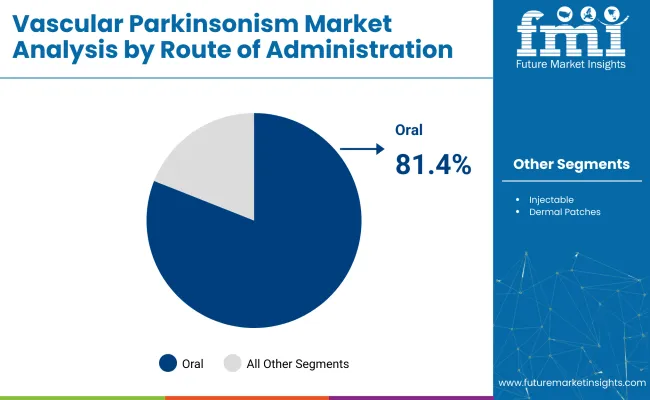
Retail pharmacy chains are projected to hold 42% of the share by 2025.
The vascular parkinsonism market is being driven by the increasing prevalence of cerebrovascular diseases and advancements in diagnostic imaging. However, challenges such as limited awareness and the complexity of distinguishing it from idiopathic Parkinson's disease are hindering industry growth.
Increasing prevalence of cerebrovascular diseases is driving industry growth
The rising incidence of cerebrovascular diseases, including strokes and small vessel disease, is significantly contributing to the demand for vascular parkinson's disease therapies.
Advancements in diagnostic imaging are enhancing early detection
Advancements in neuroimaging techniques, such as high-resolution MRI and PET scans, are improving the early detection and accurate diagnosis of vascular parkinsonism.
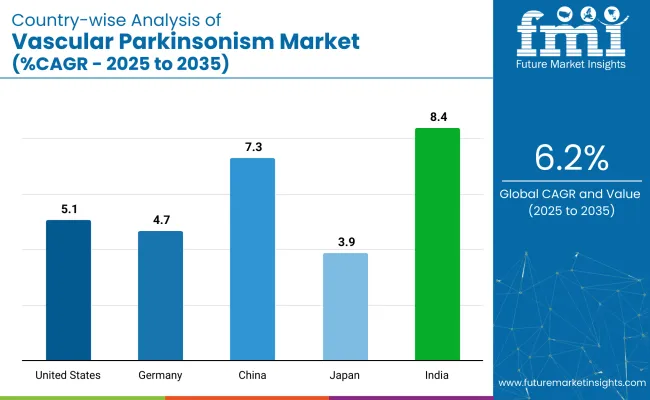
| Country | CAGR (2025 to 2035) |
|---|---|
| United States | 5.1% |
| Germany | 4.7% |
| China | 7.3% |
| Japan | 3.9% |
| India | 8.4% |
The Vascular Parkinsonism industry is expected to grow at a global CAGR of 6.20% from 2025 to 2035, with varying growth rates seen in key countries. The highest growth rate of 8.4% is expected in India, driven by an expanding healthcare infrastructure and rising demand for neurological treatments. A 7.3% growth rate is expected in China, fueled by a large population and an increasing focus on healthcare innovation.
Moderate growth of 5.1% is anticipated in the United States, as the industry remains stable with consistent demand for existing treatments. Slower growth of 4.7% is projected for Germany, while Japan is expected to experience the lowest growth at 3.9%, due to an aging population and slower adoption of new treatments. Emerging countries like India and China are expected to drive the majority of the growth, while developed industry are expected to remain stable but less dynamic.
India is expected to grow at an 8.4% CAGR through 2035, leading the vascular parkinson's disease treatment industry among major countries, particularly in the BRICS group. The demand is supported by an aging population and increasing healthcare infrastructure. Industry expansion is driven by the rising incidence of cerebrovascular diseases, as well as growing awareness of vascular parkinson's diseaseas a distinct neurodegenerative disorder. The industry growth is being accelerated by government healthcare initiatives and increasing access to affordable medical treatments.
The USA market is projected to grow at a 5.1% CAGR, reflecting steady demand for vascular parkinson's disease treatments, particularly within the OECD group. Growth is being driven by the adoption of advanced diagnostic technologies, including neuroimaging, and the aging baby boomer population. Despite the industry remaining niche, increased diagnosis and treatment adoption are being supported by government funding and the expansion of telehealth services. Significant R&D investments are being made to improve therapeutic outcomes for patients.
Germany’s market for Vascular Parkinsonism is expected to grow at a 4.7% CAGR by 2035, contributing to the growth of the EU market. The development and adoption of effective treatments are being facilitated by the country’s advanced healthcare system and robust research capabilities. Long-term care solutions are being emphasized by healthcare policies, benefiting patients. Industry expansion is being supported by an aging population and rising stroke incidence, with neuroprotective treatments being increasingly integrated into care strategies.
China is expected to grow at a 7.3% CAGR through 2035, leading the BRICS group in vascular parkinson's disease industry growth. The adoption of advanced diagnostic methods, along with greater awareness of vascular Parkinsonism, is propelling the industry. Industry development is being supported by China’s growing focus on improving healthcare systems and expanding access to specialized treatments. Government initiatives to address neurodegenerative diseases are expected to further accelerate industry growth.
The sales in Japan for Vascular Parkinsonism is projected to grow at a 3.9% CAGR through 2035, contributing to the growth of the OECD region. The demand for neurodegenerative treatments, including therapies, is being driven by the aging population. Industry growth is being supported by Japan’s emphasis on precision medicine, neuroimaging, and clinical research. Although vascular parkinson's disease remains a specialized focus, steady growth is being ensured by Japan's leadership in pharmaceutical development and healthcare technology.
Germany’s Vascular Parkinsonism demand is projected to grow at a steady 4.7% CAGR through 2035, contributing significantly to the EU market. The solid foundation for developing effective treatments is being provided by the country’s efficient healthcare system. The growth of the industry is being driven by focused clinical trials and the integration of new diagnostic technologies, such as neuroimaging and biomarkers. Additionally, the aging population and rising cases of cerebrovascular diseases are contributing to industry expansion.
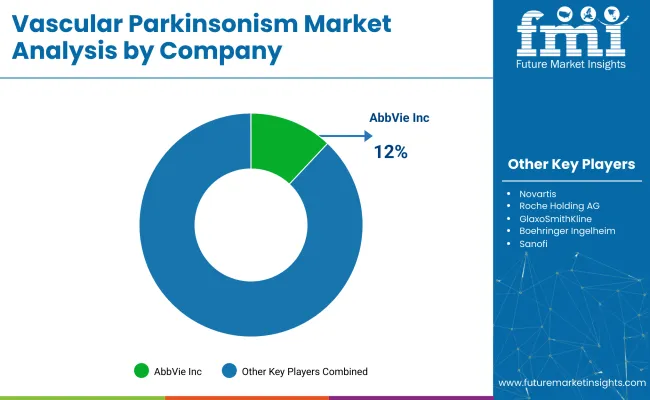
The Parkinson's disease treatment industry features a semi-consolidated competitive landscape, segmented into dominant players, key players, and emerging firms. Dominant players such as AbbVie, Merck & Co., and GlaxoSmithKline hold leading positions, supported by strong R&D pipelines, branded therapies like levodopa combinations, and global commercialization strategies. Key players including Novartis, Teva, and UCB focus on diversified neurology portfolios and next-generation dopamine agonists.
Emerging players such as Acadia Pharmaceuticals, Amneal, and Sun Pharma are expanding their presence through generics, novel delivery systems, and niche indications like non-motor symptoms and advanced-stage management, enhancing accessibility and innovation in Parkinson’s disease therapeutics.
Recent Vascular Parkinsonism Industry News
| Report Attributes | Details |
|---|---|
| Market Size (2025) | USD 319.5 million |
| Projected Market Size (2035) | USD 538.1 million |
| CAGR (2025 to 2035) | 6.20% |
| Base Year for Estimation | 2024 |
| Historical Period | 2020 to 2024 |
| Projections Period | 2025 to 2035 |
| Quantitative Units | USD million for value and million units for volume |
| Drug Classes Analyzed (Segment 1) | Dopaminergic Agents, Antithrombotic Agents, Cognitive Enhancers, Antihypertensive Agents, Muscle Relaxants |
| Routes of Administration Analyzed (Segment 2) | Oral, Injectable, Dermal Patches |
| Sales Channels Analyzed (Segment 3) | Hospitals, Neurology Clinics, Retail Pharmacy Chains, Mail-Order Pharmacies |
| Regions Covered | North America, Western Europe, East Asia, South Asia |
| Countries Covered | United States, Canada, Germany, United Kingdom, France, Italy, Spain, China, India, Japan, South Korea, Australia, Brazil, Mexico, Argentina, Saudi Arabia, UAE, South Africa |
| Key Players | Novartis, AbbVie Inc., Teva Pharmaceutical, Pfizer Inc., Roche Holding AG, GlaxoSmithKline, Boehringer Ingelheim, Sanofi, Sun Pharmaceutical |
| Additional Attributes | Dollar sales, share by drug class and route of administration, increasing demand for cognitive enhancers and antithrombotic agents, regional market growth in neurology clinics, advancements in muscle relaxants and injectable formulations |
The industry is segmented into dopaminergic agents, antithrombotic agents, cognitive enhancers, antihypertensive agents, and muscle relaxants.
The industry includes oral, injectable, and dermal patches.
The industry covers hospitals, neurology clinics, retail pharmacy chains, and mail-order pharmacies.
The industry spans North America, Western Europe, East Asia, and South Asia.
It is expected to reach USD 538.1 million by 2035.
The industry is projected to be USD 319.5 million in 2025.
The industry is expected to grow at a robust CAGR of 6.20%.
Oral administration is projected to dominate with an 81.4% share.
India is expected to be the fastest-growing country with an 8.4% growth rate.






Our Research Products

The "Full Research Suite" delivers actionable market intel, deep dives on markets or technologies, so clients act faster, cut risk, and unlock growth.

The Leaderboard benchmarks and ranks top vendors, classifying them as Established Leaders, Leading Challengers, or Disruptors & Challengers.

Locates where complements amplify value and substitutes erode it, forecasting net impact by horizon

We deliver granular, decision-grade intel: market sizing, 5-year forecasts, pricing, adoption, usage, revenue, and operational KPIs—plus competitor tracking, regulation, and value chains—across 60 countries broadly.

Spot the shifts before they hit your P&L. We track inflection points, adoption curves, pricing moves, and ecosystem plays to show where demand is heading, why it is changing, and what to do next across high-growth markets and disruptive tech

Real-time reads of user behavior. We track shifting priorities, perceptions of today’s and next-gen services, and provider experience, then pace how fast tech moves from trial to adoption, blending buyer, consumer, and channel inputs with social signals (#WhySwitch, #UX).

Partner with our analyst team to build a custom report designed around your business priorities. From analysing market trends to assessing competitors or crafting bespoke datasets, we tailor insights to your needs.
Supplier Intelligence
Discovery & Profiling
Capacity & Footprint
Performance & Risk
Compliance & Governance
Commercial Readiness
Who Supplies Whom
Scorecards & Shortlists
Playbooks & Docs
Category Intelligence
Definition & Scope
Demand & Use Cases
Cost Drivers
Market Structure
Supply Chain Map
Trade & Policy
Operating Norms
Deliverables
Buyer Intelligence
Account Basics
Spend & Scope
Procurement Model
Vendor Requirements
Terms & Policies
Entry Strategy
Pain Points & Triggers
Outputs
Pricing Analysis
Benchmarks
Trends
Should-Cost
Indexation
Landed Cost
Commercial Terms
Deliverables
Brand Analysis
Positioning & Value Prop
Share & Presence
Customer Evidence
Go-to-Market
Digital & Reputation
Compliance & Trust
KPIs & Gaps
Outputs
Full Research Suite comprises of:
Market outlook & trends analysis
Interviews & case studies
Strategic recommendations
Vendor profiles & capabilities analysis
5-year forecasts
8 regions and 60+ country-level data splits
Market segment data splits
12 months of continuous data updates
DELIVERED AS:
PDF EXCEL ONLINE
Vascular Sheath Group Market Size and Share Forecast Outlook 2025 to 2035
Vascular Patches Market Forecast and Outlook 2025 to 2035
Vascular Access System Market Size and Share Forecast Outlook 2025 to 2035
Vascular Boot Market Trends and Forecast 2025 to 2035
The Vascular Ulcer Treatment Market Is Segmented by Ulcer Type, Treatment and Distribution Channel from 2025 To 2035
Vascular Dementia Treatment Market Analysis by Drug Class, Route of Administration, Distribution Channel, and Region through 2035
Vascular Imaging Systems Market Growth - Trends & Forecast 2025 to 2035
Vascular Closure Devices Analysis by Product Type by Product, By Age Group and by Distribution Channel through 2035
Vascular Access Catheters Market - Growth & Forecast 2025 to 2035
Vascular Endothelial Growth Factor Inhibitor Market
Vascular Dressings Market
Vascular prostheses market
Vascular Screening Market
Vascular Testing Devices Market
Neovascular AMD Treatment Market Growth, Analysis & Forecast by Drug Type, Disease Type, Age Group, Gender, Stage of Disease, Distribution Channel and Region through 2035
Nonvascular Interventional Radiology Device Market Trends – Growth & Forecast 2024-2034
PET Vascular Prosthesis Market Size and Share Forecast Outlook 2025 to 2035
Endovascular Aneurysm Repair (EVAR) Market Size and Share Forecast Outlook 2025 to 2035
Endovascular Therapy Devices Market Size and Share Forecast Outlook 2025 to 2035
Non-Vascular Stents Market Growth - Trends & Forecast 2025 to 2035

Thank you!
You will receive an email from our Business Development Manager. Please be sure to check your SPAM/JUNK folder too.
Chat With
MaRIA